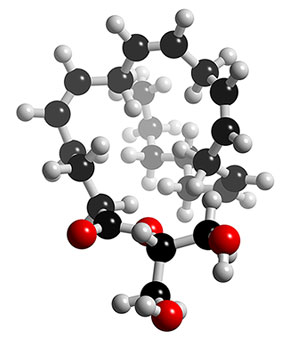“Ajulemic acid (AJA) is a synthetic analog of the tetrahydrocannabinol (THC) metabolite THC-11-oic acid; THC is a major active ingredient of the drug marijuana derived from the plant cannabis. AJA has potent analgesic and anti-inflammatory activity without the psychotropic action of THC. Unlike the nonsteroidal anti-inflammatory drugs, AJA is not ulcerogenic at therapeutic doses, making it a promising anti-inflammatory drug. However, the mechanism of AJA action remains unknown. Here we report that AJA binds directly and specifically to the peroxisome proliferator-activated receptor γ (PPARγ), a pharmacologically important member of the nuclear receptor superfamily. Functional assay indicates that AJA activates the transcriptional activity of both human and mouse PPARγ at pharmacological concentrations. Activation of PPARγ by AJA requires the AF-2 helix of the receptor, suggesting that AJA activates PPARγ through the ligand-dependent AF-2 function. AJA binding consistently enables PPARγ to recruit nuclear receptor coactivators. In addition, we show that AJA inhibits interleukin-8 promoter activity in a PPARγ-dependent manner, suggesting a link between the anti-inflammatory action of AJA and the activation of PPARγ. Finally, we find that AJA treatment induces differentiation of 3T3 L1 fibroblasts into adipocytes, a process mediated by PPARγ. Together, these data indicate that PPARγ may be a molecular target for AJA, providing a potential mechanism for the anti-inflammatory action of AJA, and possibly other cannabinoids. These studies also implicate other potential therapeutic actions of AJA through PPARγ activation in multiple signaling pathways.”
“The mood-altering drug marijuana derived from the hemp plant Cannabis sativa contains a group of biosynthetically related substances known collectively as cannabinoids. Tetrahydrocannabinol (THC), one of the major cannabinoids in marijuana, has potent analgesic and anti-inflammatory activities, but it also exhibits psychotropic effects, which limit its clinical application. Considerable effort has been expended toward the goal of creating nonpsychotropic cannabinoid derivatives that retain therapeutic actions but are free of psychotropic activity. A useful template for this search is the THC metabolite THC-11-oic acid…”


